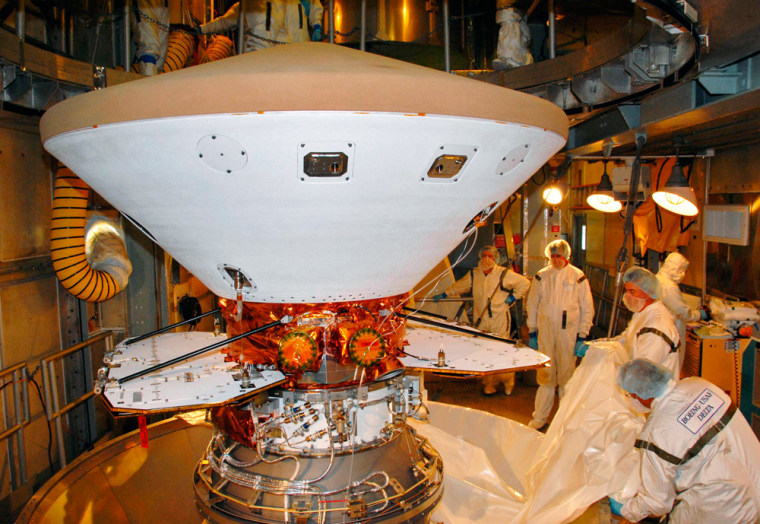The launch of NASA's latest Mars probe has been put off until Saturday at the earliest, due to bad weather back on Earth.
NASA had planned for a Friday liftoff, but on Tuesday, the space agency said severe weather at the launch site in Florida forced a delay in fueling up the second stage of the Delta 2 rocket that would send the Phoenix Mars Lander on its 10-month-long, 423-million-mile trip.
The fueling is expected to be completed on Wednesday, but the delay left "insufficient contingency time in the schedule to move forward with the planned Friday launch," NASA said in a launch update.
NASA has three weeks to launch Phoenix, but in the near term, the launch opportunities may be limited due to the space agency's plans to launch the shuttle Endeavour on Aug. 7 or later. The launch windows are governed by the orbital mechanics for going to Mars. Saturday's opportunities come at 5:26 and 6:02 a.m. ET.
Phoenix's launch marks only the start of the suspense for mission managers. The spacecraft will have to survive landing on the surface of the rocky, dusty Red Planet, which has a reputation of swallowing manmade probes. Of the 15 global attempts to land spacecraft on Mars, only five have made it.
"Mars has the tendency to throw you curveballs," said Doug McCuistion, who heads the Mars program at NASA Headquarters.
Unlike the durable twin rovers near the equator, the Phoenix Mars Lander will sit in one place and extend its long arm to dig trenches in the permafrost and scoop up soil for analysis. Made of aluminum and titanium, the 8-foot-long (2.5-meter) arm acts like a backhoe and can dig down 20 inches (50 centimeters) and rotate.
Looking for life
Although Phoenix lacks the tools to detect past or current life, scientists hope it will shed light on whether Mars' northern arctic possesses the signature ingredients for microbes to exist.
The lander is expected to conduct a three-month mission in Mars' northern plains. If successful, it will be the first time since the Viking missions three decades ago that a robot will drill beneath the Martian surface.
Once it lands, Phoenix will heat the soil samples in miniature ovens to study their chemistry. The lander can detect the presence of organics, although it won't be able to tell if there's DNA or protein, said principal investigator Peter Smith of the University of Arizona, Tucson.
Slideshow 12 photos
Month in Space: January 2014
The landing site was chosen because previous spacecraft found evidence that frozen water lurked below the surface. Some believe the shallow valley measuring about 30 miles wide might be the remnant of an ancient sea. However, Phoenix will look for evidence of liquid water that may have existed as recently as 100,000 years ago.
There's no water on the arid Martian surface today, but Phoenix's job is to find out whether the underground ice may have melted, creating a wetter environment. Scientists generally agree that water, along with the presence of organic materials and a stable heat source, is needed to support life.
To prevent Phoenix from accidentally bringing organisms to Mars, technicians had to take special care while prepping the lander for launch. It underwent dry heat treatment and precision cleaning to reduce the amount of germs on its surface. Its trench-digging arm was also sealed in a special wrapping to prevent contamination.
Phoenix is the first project from NASA's Scout program, a low-cost complement to pricier Mars missions in orbit and on the surface. Managed by the Jet Propulsion Laboratory in Pasadena, Phoenix cost $420 million compared to the hardy rovers Spirit and Opportunity, which cost $820 million to launch in 2003.
Rising from ashes
True to its name, Phoenix rose from the ashes of previous missions. It was supposed to fly in 2001 as a sidekick to the Mars Odyssey orbiter. The orbiter reached Mars, but the lander mission was canceled in the wake of back-to-back losses in 1999.
The Mars Climate Orbiter burned up as it neared Mars because Lockheed Martin/NASA mismatched metric and English measurement units. The Mars Polar Lander tumbled to its death after its rocket engine shut off prematurely as it tried to touch down on the south pole. Neither wreckage has been found.
Phoenix, built by Lockheed Martin, carries several science instruments similar to ones that flew on the ill-fated Polar Lander mission. Engineers rigorously tested the spacecraft over the last four years "to drive out any of the problems we might have in the system," said Barry Goldstein, project manager at JPL.
If Phoenix survives its primary mission, it will turn into a weather station and collect data on the atmosphere.
This report includes information from The Associated Press and MSNBC.com.

